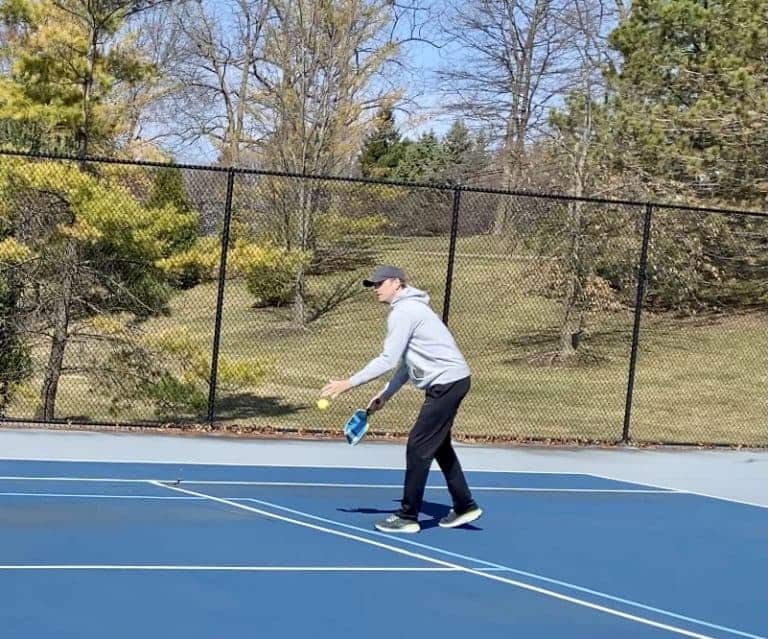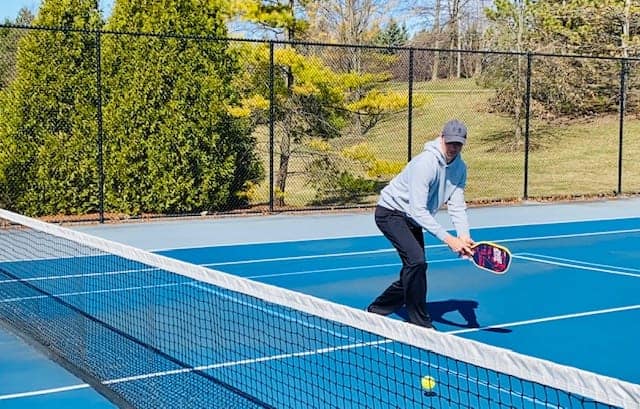What Is A Fault In Pickleball? A Simple Answer For New Players
I love the game of pickleball but one of the aspects to the game that I needed clarity on when I was first started playing was a clear answer to the question: What is a fault in pickleball?
A fault in pickleball is anything that violates the game’s rules and forces the game to stop. There are 10 ways to get a fault in pickleball, but the most common ones are hitting the ball out of bounds, volleying the return of serve, and committing a no-volley zone foot fault.
If you’re a pickleball beginner, it’s important to know the rules first, and learning more about faults and how to prevent them can help you improve your game.
I’ve created this in-depth guide to fully explain what a fault is in pickleball, how many there are and I’ll even give you some tips on how to avoid them.
What Are The 3 Faults In Pickleball?
The 3 most common faults in pickleball are:
-Hitting a ball out of bounds
-Hitting the return of serve before it bounces
-Stepping into the no-volley zone while hitting a volley
Of the three faults listed above, aside from hitting the ball out, the most common fault in pickleball is hitting the return of serve out of the air without letting it bounce.
Newer players struggle with this fault or rule all the time. It can be difficult to remember to let the return of serve bounce during the excitement of a game. Beginners or anyone with a tennis background may have instinctively run up and smash the return.
This fault is unique to pickleball and takes away the service advantage from the serving team and actually gives it to the return team.
This is solely unique to the game of pickleball.
For a complete walk through of the double bounce rule, read my guide here.
What Does A Fault Mean In Pickleball?
A fault in pickleball means that one of the players has committed an error or “fault” and either hit the ball out of bounds, hit the ball into the net or committed a “foot fault” at the baseline or no-volley zone line. A foot fault at the baseline would mean that during a serve, the foot of the player serving came over the baseline. This is a fault because the serve must take place behind the baseline.A foot fault at the non-volley zone line occurs when a player comes over the line and hits the ball without letting the ball bounce first.Coming over the no-volley zone line and hitting the ball is legal if you’ve let the ball bounce first. The no-volley zone area is the only area on a pickleball court where ground strokes are enforced.

Other Pickleball Fault Related Questions
What is a fault in pickleball? What happens if you get a fault? What does a fault mean? Are they same as in tennis? You may have a lot of questions about faults in pickleball, and I’m here to help!
Even though there is a lot to learn about faults, they quickly become second nature and muscle memory for any players.
A fault essentially boils down to a rule violation that results in the game stopping to reset. More importantly, it might cost you and your team a point or even the game!
So learning about what a fault is and how to avoid them is important.
Receiving a fault can mean different things depending on whether you’re on the serving team or the receiving team, but it’s important to commit both to memory.
There are two essential things to know about a fault:
- If you’re on the receiving team a commit a fault, a fault means that the other team receives a point.
- If you’re on the serving team and commit a fault, you forfeit serving privileges and give the serve back to the other team.
While this may seem like a less harsh consequence compared to the receiving team, it can be quite the blow to a team’s chances of winning. In pickleball, only the serving team can earn points, so losing the serve means you can’t score points.
Faults are nearly unavoidable for even the most experienced players. However, you can do your best to avoid them by familiarizing yourself with the rules and more importantly; practicing.
How To Get a Fault in Pickleball
Most faults in pickleball come down to simply player error, which, again, you can avoid once you’ve gotten the hang of the sport and lots of repetition. Here’s the list of basic faults recognized by USA Pickleball Association:
- Hitting the ball into the net on a serve or return.
- Allowing the ball to go out of bounds from your hit.
- Failing to hit the ball before it bounces twice on your side of the court.
- If you allow yourself or anything connected to you (paddle or clothes, for example) to touch the net while the ball is in play.
- If the ball hits a permanent object (like a tree or light post) before landing on the court.
- Violating the kitchen rules, which include returning or initiating a volley from the no volley zone.
- If the service is made after bouncing on the court (it must be served out of the air).
- If a player hits a ball before it passes the net.
- If the ball strikes a player or anything he or she is wearing. However, an exception to this rule is if the ball hits a player’s paddle hand on the wrist or lower.

Can You Foot Fault In Pickleball?
You can foot fault in pickleball in one of two ways. The first is at the service line if you step over it while serving. The second is at the no-volley zone line if you step over it either while hitting a volley shot or after hitting a volley but your momentum carries you over the line.
It’s important to only step over the kitchen line if you know you’re going to let the ball bounce.
If you’re not letting the ball bounce while at the kitchen, you must remember to stay behind the line during the volley and even after.
I’ve caught myself crush a high volley shot back at my opponent only to realize I’d committed a foot fault by letting my momentum carry me over the line after I had hit the ball.
I’ll now cover each type of foot fault in pickleball in more detail below.
No Volley Zone Foot Faults
Beyond the basic faults, there are also faults specifically related to the no volley zone, also known as the kitchen, in pickleball. These faults include:
- If a player or anything a player is wearing or touching goes over the kitchen line during a volley.
- If a player returns a volley while standing in the no volley zone.
Service Line Faults and Foot Faults
There are also faults specifically related to serves called service faults, including:
- If a player misses the ball in an attempt to serve.
- If the ball touches any permanent object before they service, including walls, fencing, light posts, or trees.
- If the ball touches the server’s partner or anything he or she is wearing.
- If the served ball lands in the kitchen, also known as the no volley zone.
- If the ball hits the net and lands in the kitchen or on the kitchen lines.
- If the ball lands outside of the service area.
- If the ball hits the court and lands outside of the court service boundaries.
Service Foot Faults
The final type of fault is directly related to the server’s foot position as he or she is getting ready to toss and hit the ball. These are referred to as service foot faults, with examples including:
- If the server’s feet touch the area outside of the sideline plane.
- If the server’s feet go outside of the centerline plane.
- If the server’s feet touch any part of the court.

How To Avoid a Fault in Pickleball
After seeing the lists above, you might feel a tad overwhelmed by all of the rules players must follow in pickleball. How can you possibly avoid all of these penalties while you’re still learning the game? If you’re new to pickleball, here are a few tips for avoiding faults:
- Simply knowing the rules is a great way to avoid receiving a fault. If you begin a game of pickleball without familiarizing yourself with the rules, you’re likely to earn a few faults. Do your part as a teammate and learn as much as you can about the game. This is the number one way to avoid rule violations and forfeiting points for your team.
- You can avoid faults by practicing. Like in most areas of our lives, practicing will make you a much more skilled player. Some faults might be impossible to steer clear of all of the time. But many can be avoided by spending some time on the court. Service faults, in particular, can be avoided by a couple of hours of practice per week. Eventually, you’ll receive fewer faults per game.
- One of the most common faults is related to mistakes made in the no volley zone, also known as the kitchen. This is the three-and-a-half-foot area on either side of the net that extends the width of the court. Returning or initiating a volley while standing in this zone is an automatic fault and perhaps the most common one. Avoiding these types also comes with practice.
Many players practice what’s called toeing the line, which means they get as close to possible to the kitchen line without crossing it.
There are huge benefits to toeing the line, as it gives you more control over receiving and returning the ball. However, it is a risky move for new players because the chances of getting a fault are higher.
This definitely takes practice and confidence, but getting comfortable near the no volley zone will make you a much stronger player.
Conclusion
Pickleball is one of the fastest-growing sports in popularity today, and for a good reason. It’s an exciting and fast-paced game that almost anyone can play. If you’ve recently become interested in the sport, understanding the rules and regulations is the first step to becoming a great player.
While it may seem like there are many ways to get faults in a game, new players tend to catch on quickly. Spend a little time going over the faults and then get to the court to practice. You’ll become more comfortable and confident in your skills every day.

Welcome to TheVolleyLlama.com. My name is Keith, I’m just a lover of all sports that involve a racquet, net and a ball. I played competitive high school varsity tennis, love racquetball and my whole family plays pickleball regularly. I started this website to help give people like you the basics to learn these wonderful games.

